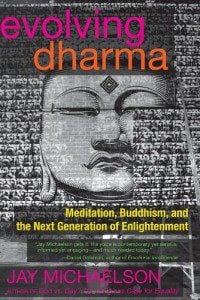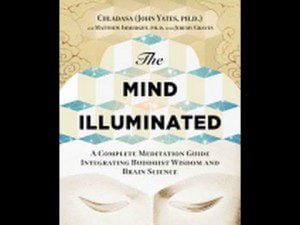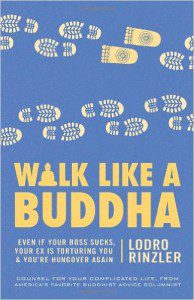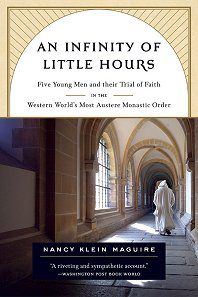This post is the second in a four-part series on “A Journey with Four Spiritual Guides: Krishna, Buddha, Jesus, and Ramakrishna.” Looking ahead briefly to the next post, liberals sometimes get anxious when Jesus is mentioned because of the many ways his message has been manipulated, abused, and used to harm others. As the old exasperated prayer goes, “Jesus, save me from your followers!” However, in my next post I hope to offer some different, potentially surprising angles on Jesus — “Rabbi Yeshua,” if you will. In contrast, many religious liberals also tend, as a whole, to be as attracted to Buddhism as they are anxious about those who drop the J-bomb (the J-bomb being “Jesus”).
To counterbalance that tendency, it may be important to note that any religion (or any secular institution for that matter) can be used to hurt as well as heal, to put down others or to lift them up. The most recent example I’ve seen along these lines is a New York Times headline last year that read, “Extremism Rises Among Myanmar Buddhists: Amid hate-filled speeches and violence, a nationwide fundamentalist movement has grown.” To share a brief excerpt of the article:
over the past year, images of rampaging Burmese Buddhists carrying swords and the vituperative sermons…have underlined the rise of extreme Buddhism in Myanmar.… Buddhist lynch mobs have killed more than 200 Muslims and forced more than 150,000 people, mostly Muslims, from their homes.
So much depend on what an individual or group brings to a tradition. Everyone — whether they admit it or not — picks and chooses the parts of a traditions to emphasize, while allowing other parts to lay dormant. And if you pick and choose, why not choose love? Why not choose compassion? Why not choose inclusion? From what I can see in the history of religions, the failure of individuals and groups to choose love, connection, and compassion says more about them than any particular religious (or secular) tradition.
Similarly, Westerners who become serious Buddhist practitioners are sometimes surprised to discover that the sexism and hierarchy they thought they were escaping from their childhood religion dominates many corners of traditional Buddhist practice. Although, just this past month, I was heartened to hear about the Zen Women Ancestors Document, which is introducing historic female Zen masters into ancient lineage rituals, which have in the past included the chanting of only male names. So while, I agree that we should be wary of throwing out centuries (or millennia) of wisdom from the traditional practices of world religions, we should also advocate for retrieving and expanding the sometimes neglected parts of those traditions that are egalitarian and oriented toward social, economic, and environmental justice.
Along these lines, I blogged last year about “Pragmatic Buddhism, Westernized Dharma, 21st-century Sangha.” And as much as I sometimes appreciate the beauty and power of tradition and ritual, the strand of Buddhism that I’m most drawn to has at least three features:
- pragmatic, focused on “what works” in cultivating awakening, clarity, and equanimity — and letting go of the rest,
- westernized — open to the influence of the best of Western culture, especially gender egalitarianism and democracy, and
- twenty-first century-oriented — open to the best of modern science, especially technology, psychology. and neuroscience.
One of the best books I’ve read recently related to those themes is Jay Michaelson’s excellent book Evolving Dharma: Meditation, Buddhism, and the Next Generation of Enlightenment. Reading that book inspired this post, and parenthetic page numbers in this post refer to Michaelson’s text.
 Related to Pragmatic Buddhism, it’s important to note that Buddhism generally comes from the title Buddha, which means “Awakened One.” That title was given to a historical figure named Siddhartha Gautama, who 2,500 years ago, “awakened” to a new way of perceiving and experiencing the world that eliminates suffering — or perhaps, better translated, eliminates “unsatisfactoriness.” That’s the point. And to the extent that tradition rituals and practices help with that process, wonderful, we should hold on to them. And to the extent that pragmatism, western culture, and twenty-first century knowledge help catalyze that process of liberation from suffering, we should use those tools (or “skillful means”) as well.
Related to Pragmatic Buddhism, it’s important to note that Buddhism generally comes from the title Buddha, which means “Awakened One.” That title was given to a historical figure named Siddhartha Gautama, who 2,500 years ago, “awakened” to a new way of perceiving and experiencing the world that eliminates suffering — or perhaps, better translated, eliminates “unsatisfactoriness.” That’s the point. And to the extent that tradition rituals and practices help with that process, wonderful, we should hold on to them. And to the extent that pragmatism, western culture, and twenty-first century knowledge help catalyze that process of liberation from suffering, we should use those tools (or “skillful means”) as well.
There are, of course, many ways that Western culture can distract us from the Buddhist path. For instance, I heard a recent interview with someone who is both a software designer and mindfulness coach in which he noted that
they’re using behavioral engineering in a lot of the design of new products. And one of the ways that they create addictive technologies is…called “variable reward,” which they did [in] two experiments with two different rats.
One rat when he pulled the lever, they would give him a portion of food, just one portion. And the rat ended up pulling the lever three times a day just whenever he was hungry. The other rat they gave him what was called the variable reward, which means he would pull the lever sometimes he would get less than a portion, sometimes he would get more than a portion, sometimes he would get one portion, sometimes he wouldn’t get anything.
And the rat just stood there all day pulling the lever…. And so the design of products is using this to create technologies that create addictive behavior. So you can see that variable reward system at play in Twitter or Facebook. You know these streams that you’re scanning and you’re saying to yourself “good, good, bad, good, good, bad. That’s good. Share.”
It’s all this variable reward system. And the other thing is the infinite scroll. So there’s no end to it. You scroll forever and there’s endless variable reward content there for you. It’s kind of the downside of technology is that we’re learning so much about how we’re programed that companies are optimizing their products to be more addictive so that we’ll engage more with their product….
[I]t’s more important than ever for people to have some kind of a practice to know if your subtle desires are being manipulated. And why are you engaging in this particular behavior all the time automatically? You know when you see that notification on your phone or that little #1 next to your app or whatever…. [W]hat is that feeling like and what is that drive to want to open it and know what’s there and just explore that a little bit?
At the same time, there are also many exciting ways that the modern world is contributing to the development of “Buddha as spiritual guide,” and there are likely many more breakthroughs to come. Consider this trend: “In 1980, not a single article was published in a scientific journal on the effects of meditation and mindfulness. In 1990, there were five. In 2000, twenty-one. But in 2010, there were 353; in 2011, 397; and in 2012, there were 526” (30).
These scientific studies give data to support the growing awareness of how much meditation and mindfulness-based stress reduction can improve quality of life and long term health (32-35). In the corporate world, Google offers its employees a meditation program called “Search Inside Yourself,” and the U.S. Marines have developed a “Mindfulness-based Mind Fitness Training, or M-Fit” (22). And one logical prediction is thatthe scientific and medical establishment will come to see “contemplative fitness” for our mental health as equally essential to physical fitness for our bodies (x).
From a secular perspective, some have called the use of modern technology to supplement mindfulness techniques “brainhacking” (x) — such that in addition to the millennia old language of the Buddhist suttas (“I teach suffering, and the end of suffering”), we also get twenty-first century Buddhist teachings — what Siddhartha himself might teach if he had been born today instead of 2,500 years ago — such as, “My amygdala no longer drowns out my left prefrontal cortex. In other words, I am happy” (xiii).
The amygala is, of course, a vital part of our brain. It controls instinctual responses, and has been called the “fight or flight,” “have-sex-with-it-or-kill-it” part of the brain (35-6). This inheritance from our reptilian ancestors can save our live in a high-threat situation, but Buddhist practices can help us avoid living in that state of ratcheted-up anxiety all the time — and instead cultivate those more evolved parts of ourselves that the prefrontal cortex makes possible: compassion, clarity, concentration, equanimity. And to extend the physical fitness / contemplative fitness analogy made earlier, Michaelson has said that, “Just like doing curls at the him builds larger biceps, meditating on the cushion builds a stronger prefrontal cortex (more or less)” (43).
And related to what all that meditating accomplishes, keep in mind the key point that the name Buddha is a title meaning “Awakened One.” (Buddha isn’t Siddhartha’s name — just like “Christ” isn’t Jesus’ last name; it’s a title meaning “Anointed One,” but more on that next post.) The point is that there can sometimes be a misunderstanding that Buddhism is about having a certain experience called “Enlightenment.” More accurately, the process is to awaken to a different way of perceiving and experiencing the world. It’s about experiencing every emerging moment “clearly, richly, and honestly. It’s not the what — it’s the how” (43).
Put more radically, the most essential, original teaching of the historical Buddha was precisely not to create Buddhists. The point is to awaken, to wake up to the truth that you are a Buddha with the capacity within you to become just as much as “Awakened One” as Siddhartha Gautama did 2,500 years ago and as many others have since. (And I mean that seriously: “The goal is to become a Buddha, not a Buddhist.) In contrast to Alice in Wonderland’s Mad Hatter, who proclaims, “Why, sometimes I’ve believed as many as six impossible things before breakfast, ”Buddhism is much less about what you believe and much more about what you come to perceive in the crucible of your direct, firsthand experience. (Very similar points can be made about how Jesus taught a “Way” of being in the world not a set of beliefs. And similar misunderstandings beset the legacy of both Jesus and Buddha after their deaths such as Buddha being called an avatar of Vishnu, just like Krisha, who we discussed last week.)
Returning our focus back to Buddha-as-spiritual-guide, I mentioned earlier the comparison of meditation time on the cushion to exercising at the gym. While both are good for your longterm health, help you sleep better, and decrease anxiety (among a long list of other benefits), they are also both work and take discipline. To quote Michaelson, “If a vacation banishes all care from the mind, a meditation retreat puts them right smack in front of you” (24). And we often need to supplement the bumper-sticker Buddhism of “Be Here Now” with “strive diligently to gain your liberation” from suffering (94).
Meditation isn’t about zoning out; it’s about penetrating deeply into the truth of your everyday experience and of reality (what’s sometimes called “insight”) and it’s about strengthening your prefrontal cortex (what’s sometimes called “concentration”), so that it comes to be second nature for everyday life to trigger — not your amygdala, that “flight-or-fight” reptile part of our brains — but for our second nature to be characteristics such as compassion, clarity, and equanimity irrespective of whatever arises in our experience.To make that same point from a slightly different angle, the most important part of becoming a Buddha isn’t some blissed-out, unitive experience that happens on a meditation mat (as wonderful as that may be), it’s about integrating the fruit of that practice into your everyday life: bringing compassion, clarity, and connection into your relationship with yourself; bringing compassion, clarity, and connection into your relationship with your family, friends, colleagues; bringing compassion, clarity, and connection into your relationship with this planet and our place in the universe.
And if you do strive diligently in Buddhist practices to attain your liberation, it’s vital to remember that your life will not be perfect (whatever that would even mean). A central Buddhist teaching is that everything is impermanent. Science teaches us the same truth: everything in the universe is always already in the process of changing, evolving, and everything dying. Everything in the universe is “arising and passing away.” In the end, entropy wins. We can’t change impermanence. But the Buddhist path invites us to consider that the most sane response to impermanence might be to accept that truth, and concentrate on what we have the most control over: our response, our potential for bringing compassion, clarity, and connection to whatever comes our way. From the Buddhist perspective, the only alternative to this choice is to resist the truth of impermanence, to let our amygdala guide us, and thereby create more suffering for ourselves, those around us, and this planet.
Remember the rat, who was manipulated by the variable reward system such that he “just stood there all day pulling the lever”? Well, a Buddhist monk
once described our situation as being like that of a donkey, tethered to a cart, with a carrot dangling just in front of its face. The donkey strives for that carrot, pulling the cart along, convinced that if it can just get a bite, it will be happy. When really, of course, what would make the donkey happiest would be to set down the burden. (47)
The Buddha as spiritual guide invites us to lay our burden down. To step off the wheel of seeking perfection, and learn to go with the flow of impermanence — which is our reality whether we like it or not.
But Buddhism doesn’t just teach impermanence. It also teaches about the interconnectedness of all reality — what in my Unitarian Universalist tradition we call our Seventh Principle, “the interdependent web of all existence.”Leonard Cohen says it this way, “If you don’t become the ocean, you’ll be seasick everyday.”
May all beings come to embrace their part in the ocean of our existence.
May we be filled with loving-kindness.
May we be peaceful and at ease.
May we be well.
Related Posts
“Pragmatic Buddhism, Westernized Dharma, 21st-century Sangha”: http://www.patheos.com/blogs/carlgregg/2013/05/pragmatic-buddhism-westernized-dharma-21st-century-sangha/
Notes
- avatar of Vishnu — David Kalupahana, Buddhist Philosophy: A Historical Analysis, 9, 88.
The Rev. Dr. Carl Gregg is a trained spiritual director, a D.Min. graduate of San Francisco Theological Seminary, and the minister of the Unitarian Universalist Congregation of Frederick, Maryland. Follow him on Facebook (facebook.com/carlgregg) and Twitter (@carlgregg).
Learn more about Unitarian Universalism:
http://www.uua.org/beliefs/principles












